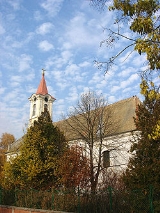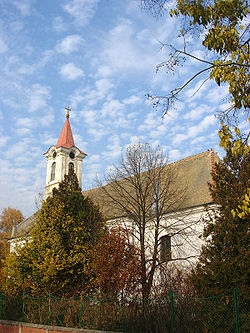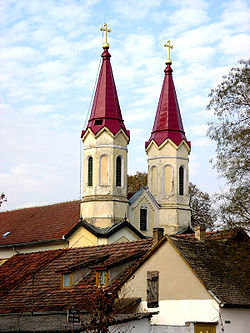
Doroslovo
Encyclopedia


Serbia
Serbia , officially the Republic of Serbia , is a landlocked country located at the crossroads of Central and Southeast Europe, covering the southern part of the Carpathian basin and the central part of the Balkans...
. It is located in the municipality of Sombor
Sombor
Sombor is a city and municipality located in northwest part of Serbian autonomous province of Vojvodina. The city has a total population of 48,749 , while the Sombor municipality has 87,815 inhabitants...
, West Bačka District
West Backa District
West Bačka District is a northern district of Serbia. It lies in the region of Bačka, in the autonomous province of Vojvodina. It has a population of 215,916...
, Vojvodina
Vojvodina
Vojvodina, officially called Autonomous Province of Vojvodina is an autonomous province of Serbia. Its capital and largest city is Novi Sad...
province. The population of the village numbering 1,830 people (2002 census) and most of its inhabitants are ethnic Hungarians. Villagers are mostly preoccupied with farming. It is widely known as a Christian
Christianity
Christianity is a monotheistic religion based on the life and teachings of Jesus as presented in canonical gospels and other New Testament writings...
pilgrimage site.
Location
Doroslovo is located between SomborSombor
Sombor is a city and municipality located in northwest part of Serbian autonomous province of Vojvodina. The city has a total population of 48,749 , while the Sombor municipality has 87,815 inhabitants...
and Novi Sad
Novi Sad
Novi Sad is the capital of the northern Serbian province of Vojvodina, and the administrative centre of the South Bačka District. The city is located in the southern part of Pannonian Plain on the Danube river....
, 15 km from Sombor, 60 km from Novi Sad and 45 km from Osijek
Osijek
Osijek is the fourth largest city in Croatia with a population of 83,496 in 2011. It is the largest city and the economic and cultural centre of the eastern Croatian region of Slavonia, as well as the administrative centre of Osijek-Baranja county...
in Croatia
Croatia
Croatia , officially the Republic of Croatia , is a unitary democratic parliamentary republic in Europe at the crossroads of the Mitteleuropa, the Balkans, and the Mediterranean. Its capital and largest city is Zagreb. The country is divided into 20 counties and the city of Zagreb. Croatia covers ...
, across the Danube
Danube
The Danube is a river in the Central Europe and the Europe's second longest river after the Volga. It is classified as an international waterway....
bridge.
Ethnic groups (2002 census)
Ethnic groups in the village include:- 952 (52.02%) Hungarians
- 659 (36.01%) SerbsSerbsThe Serbs are a South Slavic ethnic group of the Balkans and southern Central Europe. Serbs are located mainly in Serbia, Montenegro and Bosnia and Herzegovina, and form a sizable minority in Croatia, the Republic of Macedonia and Slovenia. Likewise, Serbs are an officially recognized minority in...
- 84 (4.59%) CroatsCroatsCroats are a South Slavic ethnic group mostly living in Croatia, Bosnia and Herzegovina and nearby countries. There are around 4 million Croats living inside Croatia and up to 4.5 million throughout the rest of the world. Responding to political, social and economic pressure, many Croats have...
- 39 (2.13%) YugoslavsYugoslavsYugoslavs is a national designation used by a minority of South Slavs across the countries of the former Yugoslavia and in the diaspora...
- 39 (2.13%) Roma
- Others.
History
The miracle fountain shrine of Bajkut (Бајкут, Bajkút), now called Sentkut (Сенткут, Szentkút - holy well) is located close to the village of Doroslovo. It has been known since the Middle AgesMiddle Ages
The Middle Ages is a periodization of European history from the 5th century to the 15th century. The Middle Ages follows the fall of the Western Roman Empire in 476 and precedes the Early Modern Era. It is the middle period of a three-period division of Western history: Classic, Medieval and Modern...
when the area belonged to the Kingdom of Hungary
Kingdom of Hungary
The Kingdom of Hungary comprised present-day Hungary, Slovakia and Croatia , Transylvania , Carpatho Ruthenia , Vojvodina , Burgenland , and other smaller territories surrounding present-day Hungary's borders...
.
Doroslovo probably was the location of a monastery founded in the 12th century and a church built in memory of the martyr St. Lõrinc, which is now ruined and forgotten. The first documents of Bajkut (Bajkút) as a parish are from 1382 and the existence of a fountain with miraculous powers was mentioned already then. The settlement became the property of the nuns and remained so for a very long time until the Ottoman
Ottoman Empire
The Ottoman EmpireIt was usually referred to as the "Ottoman Empire", the "Turkish Empire", the "Ottoman Caliphate" or more commonly "Turkey" by its contemporaries...
conquest in the 16th century.
During the Ottoman rule (16th-17th century), Doroslovo is mentioned as a place populated by ethnic Serbs
Serbs
The Serbs are a South Slavic ethnic group of the Balkans and southern Central Europe. Serbs are located mainly in Serbia, Montenegro and Bosnia and Herzegovina, and form a sizable minority in Croatia, the Republic of Macedonia and Slovenia. Likewise, Serbs are an officially recognized minority in...
. Since the end of the 17th century it was part of the Habsburg Monarchy
Habsburg Monarchy
The Habsburg Monarchy covered the territories ruled by the junior Austrian branch of the House of Habsburg , and then by the successor House of Habsburg-Lorraine , between 1526 and 1867/1918. The Imperial capital was Vienna, except from 1583 to 1611, when it was moved to Prague...
and since 1918 part of the Kingdom of Serbs, Croats and Slovenes and subsequent South Slavic
South Slavs
The South Slavs are the southern branch of the Slavic peoples and speak South Slavic languages. Geographically, the South Slavs are native to the Balkan peninsula, the southern Pannonian Plain and the eastern Alps...
states.
Holy water
According to the legend, The Holy Mother has appeared at the fountain Sentkut (Szentkút) on several occasions and it is believed that she asked GodGod
God is the English name given to a singular being in theistic and deistic religions who is either the sole deity in monotheism, or a single deity in polytheism....
to give healing power to the water of the well. Many miraculous events have been linked with Sentkut (Szentkút).
In 1792, a 40 year old blind man, Janos Zabloczky was told by The Holy Mother in a dream, to go to Doroslovo and wash his eyes in the Sentkut (Szentkút) water and he gained his sight back. The priests of Doroslovo have since then noted many healings at the shrine. Many believers, including the blind and crippled are visiting the shrine, hoping for blessing, recovery and peace of mind and the number of pilgrims have greatly increased.
Church
The first chapel in honour of The Holy Mother was built in 1796. A new one replaced it in 1809 but was destroyed by fire after 50 years. A third chapel was made of bricks in 1825 and rebuilt and enlarged into the present church with the addition of two towers in 1875. A sculpture of Virgin Mary was erected close by the well in 1861 and a Lourdes cave shrine with a statue of St. Mary was consecrated in 1910.A building with a long outside corridor, to be used for confessions was built in 1909 and the whole area was turned into a nice park with trees and bushes. The outside of the church was renovated in 1942 but the coloured glass windows were demolished during World War II
World War II
World War II, or the Second World War , was a global conflict lasting from 1939 to 1945, involving most of the world's nations—including all of the great powers—eventually forming two opposing military alliances: the Allies and the Axis...
. The inside of the church was renovated in 1967. An open-air altar attached to the outside of the church was consecrated in 1974 and fresco paintings by Lajos Horvath were made behind the open-air altar, on the walls of the confessional corridor and on the outside of the nearby caretaker’s house.

